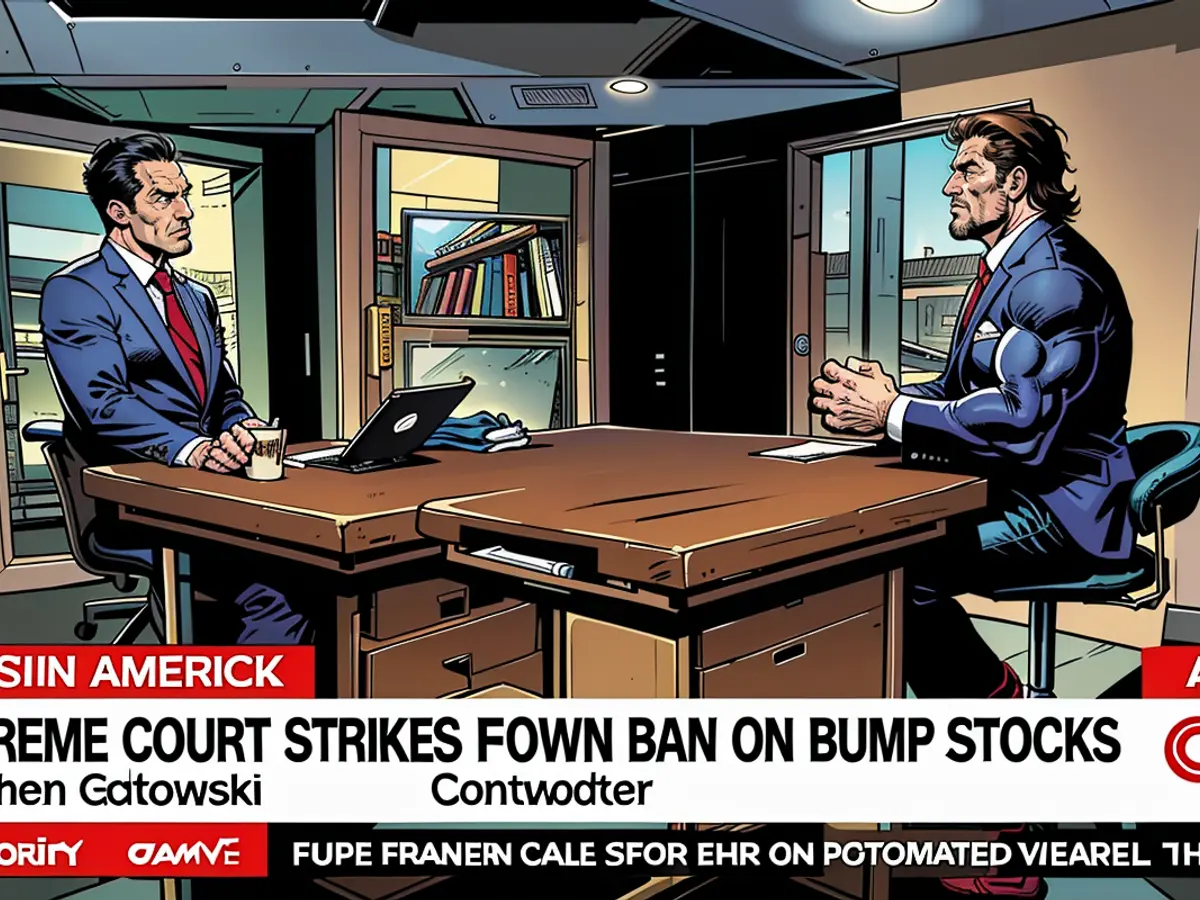Judgment: Supreme Court's ruling on bump stocks marks a significant setback
In 2013, Slide Fire Solutions introduced a gadget known as a "bump stock," which enabled a semi-automatic rifle to behave like a fully automatic one, skillfully dodging the ban on machine guns. As stated by Brandon Renner, a representative from Slide Fire, this device "sprays like a fire hose." He suggested that no more than 30 rounds should be loaded on the belt; however, a user could make it bigger as they desired.
Fast forward to October 2017, when a former accountant named Stephen Paddock used a bump stock to inflict havoc on a music festival crowd in Las Vegas, resulting in the death of 58 people and injuring around 500 others. This incident marked the deadliest mass shooting in US history carried out by a single individual with legally owned equipment. Following this, then-President Trump advocated for a ban, and the Bureau of Alcohol, Tobacco and Firearms and Explosives (ATF) updated its regulations to classify bump stocks as machine guns. This was a rare instance of progress in a heated gun debate, signaling that there were bounds. Or not.
On a contrary note, in 2021, the Supreme Court nullified the federal ban on bump stocks initiated during the Trump era, criticizing the ATF for an "abrupt" reversal of its own criteria. Justice Clarence Thomas delivered a technical analysis of the term "machine gun" and excluded bump stocks from its scope. Concerned citizens should take note of this decision and the twisty linguistics employed to justify it. The court appears to be regressing.
The ruling in Garland v. Cargill states that the ATF lacks the authority to prohibit the sale of bump stocks because they do not fit the definition of a machine gun as per the National Firearms Act of 1934. Here, a machine gun is defined as a weapon that can fire more than one shot automatically without manual reloading "by a single function of the trigger." This point, repeatedly emphasized in the opinion, is the core of Thomas' argument as he defends the court's decision to legalize the deadly devices.
While acknowledging that bump stocks allow assault rifles to discharge bullets at an alarming speed, Thomas argued that the device necessitates the trigger to be pressed and released rapidly due to the weapon's recoil, thus not meeting the technical definition of a machine gun that fires by a "single" trigger movement. This leads us down a path of semantics.
By continually pressing the bump stock, Thomas admits, the gun will fire rapidly and seemingly continuously. However, this is not automatic fire; only the illusion of it. For the trigger still needs to move back and forth. The bump stock facilitates this, transforming an ordinary shooter into a quick-fingered virtuoso. Nevertheless, it all comes down to the manipulation of an innocent assault rifle. It doesn't change the core of the weapon, Thomas reasons, as the rapidity originates from a part not identified as "the trigger." Consequently, the court cannot recognize it as a machine gun. And that's it.
The debate is reinforced with quotes from the Oxford English Dictionary and the American Heritage Dictionary, which explain that a trigger is "the lever pressed by the finger to discharge a firearm." These insights won't mean much to the Las Vegas festival goers of 2017.
Subscribe to CNN Opinion's weekly newsletter
- Subscribe to CNN Opinion's weekly newsletter.
- Follow us on Twitter and Facebook
This is what we have reached: a relentless adherence to literalism, defiant of the essence and intent of the law. In the oral argument, Thomas acknowledged that the initial push to ban machine guns was driven by the destruction they caused and — as he put it — "people dying, et cetera." Yet, none of this is permitted to trespass on the hallowed ground of the text, as he wishes to interpret it. A more persuasive view is offered by Justice Sonia Sotomayor, who proposes: "A bump-stock-equipped semi-automatic rifle is a machinegun because, with a single pull of the trigger, a shooter can fire continuous shots without any human input beyond maintaining forward pressure."
The court's capacity to construct an argument from its opposite is nothing new.
This same tactic was employed in the landmark District of Columbia v. Heller decision of 2008 — when the right to bear arms in the state militia became the right to own a gun for self-defense. As here, it was dictionaries and the presumed logic of words — rather than history itself — that defined the meaning. Under this principle, nothing is secure. Neither are we.
There is something audacious in a Supreme Court that can demolish gun laws by tugging at words, manipulating phrases. There are numerous reasons to consider reforming the higher court. Decisions such as this ought to be high among them.

Read also:
After the Supreme Court's decision, various individuals expressed their opposing opinions on the ruling. Some praised the court for upholding the Second Amendment rights, while others criticized it for endangering public safety.
In light of this decision, gun control advocates argue that the Court's interpretation of the term "machine gun" is outdated and fails to consider the potential harm caused by devices like bump stocks. They believe that more stringent regulations are necessary to prevent mass shootings.







